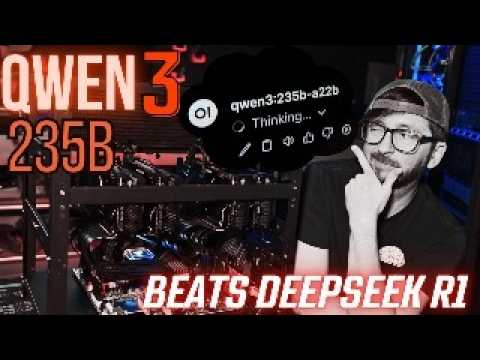The video reviews Quinn 3, a 235-billion-parameter reasoning AI model that demonstrates advanced thinking and reasoning capabilities, outperforming previous models like DeepSeek R1. Despite some limitations in creative tasks and lengthy processing times for complex prompts, Quinn 3 proves to be a valuable auxiliary tool, especially when GPU acceleration is utilized, marking a significant advancement in AI reasoning technology.
The video provides an in-depth review of Quinn 3, a 235-billion-parameter reasoning model that demonstrates impressive thinking capabilities, surpassing previous models like QW. The presenter highlights the model’s advanced reasoning abilities, noting that it is a significant step forward in AI thinking models. The review focuses on the 235B version, which is the largest available, and emphasizes its high quality and performance, although some trade-offs are acknowledged, especially when compared to larger models like Llama 4 or Gemma 3.
The testing setup involves multiple hardware rigs, including a quad GPU system with four 3090s, a high-performance 7995WX system, and a smaller HP Z440. The presenter runs the model on these different rigs to evaluate inference speed and performance across CPU and GPU configurations. The tests include various prompts, from reasoning tasks to code generation and simple questions, with the goal of assessing how well Quinn 3 performs in real-world scenarios. The results show that GPU offloading significantly improves performance, but even CPU-only inference remains viable, especially on powerful systems.
Throughout the testing, Quinn 3 demonstrates strong reasoning skills, successfully handling complex prompts like creating a Python game, solving logic puzzles, and making ethical decisions in hypothetical scenarios. The model’s responses are detailed, justified, and show a high level of understanding, although some tasks, like generating SVG images of a cat, reveal limitations in visual or creative accuracy. The model’s reasoning speed varies depending on the hardware, with the fastest responses coming from the high-end systems, but even the CPU-only setups produce acceptable results.
The presenter discusses the model’s performance in terms of tokens per second, noting that it takes considerable time to think through difficult questions, sometimes over an hour for complex prompts. Despite this, Quinn 3 outperforms previous models like DeepSeek R1, especially in reasoning tasks, and maintains its performance better under load. The model’s ability to reason deeply makes it more suitable as an auxiliary tool rather than a daily driver, but its speed and reasoning capacity make it a valuable addition to AI workflows, especially when GPU offloading is used effectively.
In conclusion, Quinn 3 is a highly capable reasoning model that marks a significant improvement over earlier versions. It performs well across different hardware configurations, with GPU acceleration providing the best results. While it is not yet ideal for everyday use due to its lengthy processing times for complex tasks, it excels as an auxiliary reasoning tool. The presenter invites viewers to participate in community polls to evaluate specific tasks, such as the cat SVG and the Armageddon scenario, and emphasizes ongoing testing of smaller models and future versions like DeepSeek R2. Overall, Quinn 3 represents a major step forward in AI reasoning, with promising potential for future applications.
